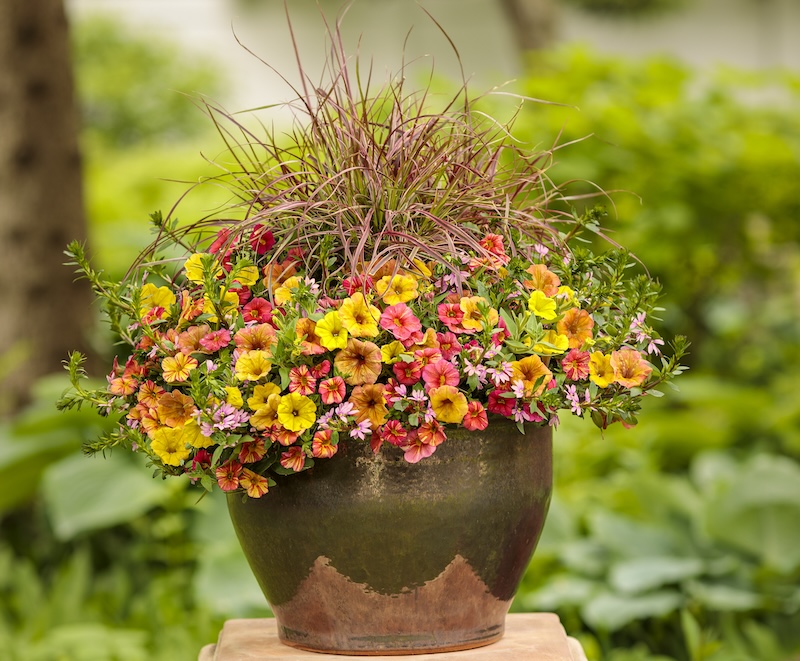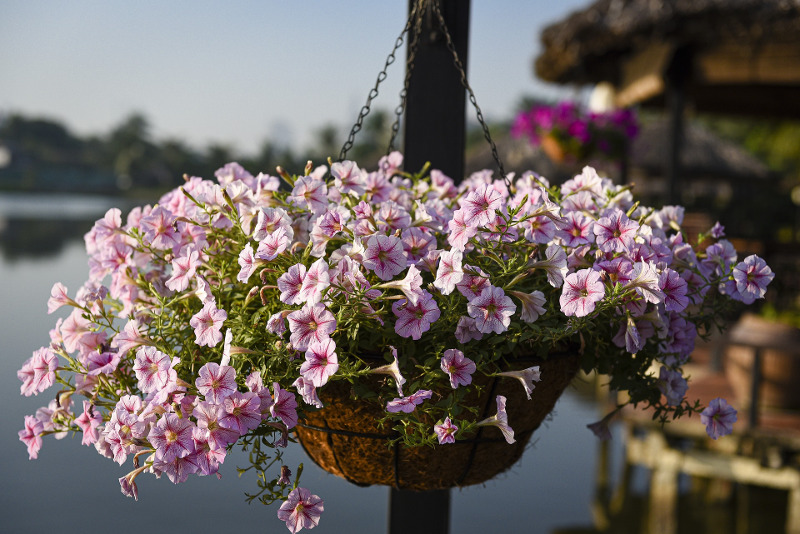Petunias are adaptable plants that can thrive in the ground or planters. Their relatively easy care requirements and abundant flowers make Petunias a very popular choice for containers and hanging baskets. These stunners will bloom from the spring through the fall and add greenery and blooms to porches and patios.

Some varieties naturally maintain a more compact look, while trailing types add a dramatic burst of color as they overflow their containers. Growing Petunias in pots is very easy, especially if you follow some simple care tips.
Planting Petunias in Pots
Petunias can be planted throughout the growing season, but it is most common to plant during the spring. You can plant Petunias as long as there is no chance of a frost, and with the right conditions and care, the plants will last into the fall. Keep in mind that Petunias planted later in the growing season will not have very established root systems and will need water more often to combat warm temperatures.
Petunias are very well suited to drier soil and warm temperatures, so containers are a natural fit since the soil dries out and heats up rather quickly. Petunia plants are not very particular regarding the pots they call home. As long as the pot has a drainage hole and enough space for the roots to spread, the plant will thrive. Generally, try to plant no more than 3 Petunias in a 12-inch pot.
Porous planters, like unglazed ceramic and terracotta, allow the soil to dry out more quickly, which is suitable for Petunias. However, you will need to water the plants more often if the soil is drying out more quickly. Non-porous planters, like glazed ceramic and plastic, are also good choices, as long as they have drainage.

Best Soil For Petunias in Pots
Rich soil high in organic content, like manure or compost, is good for Petunias. These plants are heavy feeders, and quality soil will lead to more vigorous growth. It is essential to use well-draining soil. Petunias like a good, deep watering, but they also like to dry out, and a soil that allows water to pass through will allow for healthy roots and a robust plant.
Caring For Petunias in Planters
Check the soil every few days and water potted Petunias when the top 1 to 2 inches of the soil feel dry. When you check the soil, make it a point to remove any deadheads or spent flowers to keep the plant looking good and ensure air can circulate around the greenery. Petunias respond very well to high levels of light and generally need at least 6 hours of sunlight each day. If you notice the plant leaning or reaching to one side, rotate the container to promote even and consistent growth.
Petunias tend to look leggy, especially the trailing varieties commonly used in hanging baskets. Trim back sections with sparsely spaced flowers to promote new growth, or routinely trim back about ⅓ of the plant. It seems counterintuitive, but cutting the plant back will stimulate new growth and can create a much more full and productive plant.
Watering Petunias in Pots
Petunias like sunny spots, which help the plants grow and bloom, but it also causes the soil to dry out more quickly. Plan on checking potted Petunias every few days and water when the top couple of inches of soil are dry. The plant may need water more often during particularly dry or hot periods.

Fertilizing Petunias in Pots
Feed Petunias in pots every other week using a balanced liquid fertilizer like 8-8-8 or 10-10-10. Petunias are heavy feeders, and we recommend keeping up with a regular fertilizing schedule to promote healthy growth and plentiful blooms.
Winter Care For Petunias in Pots
Petunias are tender perennials which means they only grow as perennials in warm areas. Typically, USDA growing zones 9 through 11 are warm enough to support Petunias through the winter. In zones 8 and lower, Petunias are customarily grown as annuals, meaning it is common to toss Petunias in with the compost once there is a chill in the air.
Potted Petunias can overwinter in a protected area like a garage or basement. Cut the plant back to about ⅓ of its size and inspect the plant to ensure there are no pests or other issues. The Petunia should be allowed to go dormant. New growth will appear in the spring if everything goes according to plan.
The transition can be challenging, and the Petunia may drop all of its leaves after being brought indoors. If that happens, sit tight until spring, and if the roots are still alive, new greenery will emerge. Dead growth can be cut away at that time, and when the temperatures are consistently warm, the Petunia can be moved outside.
Can Petunias Be Grown Indoors
Petunias can be grown indoors as houseplants, but it can be tricky. Place the potted Petunia in a warm area that receives lots of bright sunlight and water when the very top of the soil starts to dry out. Petunias typically go dormant, and the plant needs lots of light to resist this natural urge. You may need to use a grow light to keep a Petunia growing throughout the winter. If the plant has a dormancy period, let it happen and wait until the spring to see if the Petunia starts growing again.
Moving indoors can be stressful, so the foliage may drop. If the Petunia loses its leaves, move the plant to a protected area and wait until the spring to see if the plant starts growing again.
 |
Author Alison Cotsonas - Published 12-16-2021 |
